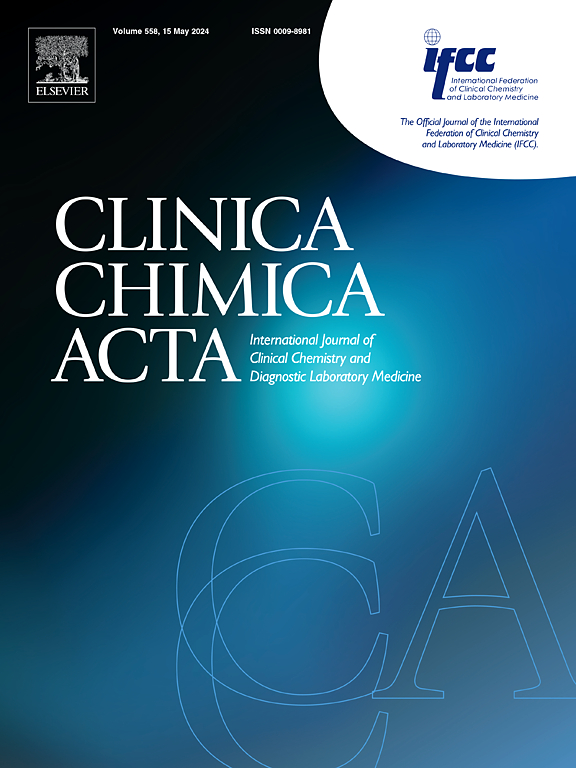中国CKD的gfr:系统综述。
IF 3.2
3区 医学
Q2 MEDICAL LABORATORY TECHNOLOGY
引用次数: 0
摘要
目的:这是一项基于证据的研究,旨在评估哪一种基于肌酐的方程对估计中国成人慢性肾病(CKD)患者的肾小球滤过率(eGFR)最有用。方法:检索多个数据库,收集2009年1月至2023年1月中国成人CKD患者中、英文肌酐eGFR方程相关研究,采用“肾小球滤过率”、“GFR方程”、“中国CKD”、“慢性肾病”、“方程编制”和“方程验证”。采用RevMan 5.4软件对每项研究的诊断试验准确性进行评价。由2名独立研究者记录每个纳入方程的方程名称、研究发表年份、第一作者、eGFR参考方法、CKD编号、个体年龄(年龄范围)、mGFR值、偏倚、精度和30%准确率(P30)。结果:在纳入的838项研究中,基于6个基于肌酐的GFR方程的23项研究被纳入本综述,即CKD-EPI、Asian modified CKD-EPI、FAS、EKFC、Xiangya和BSI1方程。共纳入2979例CKD患者进行FAS方程外部评价,总P30为72.6%;970例CKD患者符合EKFC方程,总P30为73.1%。对平均eGFR在39.7 ~ 47.6 mL/min/1.73 m2之间的1778例CKD患者(≥60岁)进行汇总,评估BSI1方程的预测准确性,结果表明偏差较小(-3.8 ~ 3.5 mL/min/1.73 m2),精度极好(10.2 ~ 16.8 mL/min/1.73 m2),总P30为69.6%。结论:目前,中国成人CKD患者的FAS和EKFC方程中eGFR的P30较高。对于≥60岁老年人的eGFR, BSI1配方的偏倚和精度是可以接受的,而P30相对较低。因此,临床需要制定更准确的老年CKD成人eGFR方程。虽然这些发现很有希望,但需要在大型对照临床研究中进一步验证。本文章由计算机程序翻译,如有差异,请以英文原文为准。
GFRs in Chinese CKD: A systematic review
Purpose
This was an evidence-based study to assess which creatinine-based equation was most useful for estimated glomerular filtration rate (eGFR) in Chinese adults with chronic kidney disease (CKD).
Methods
Multiple databases were searched to collect relevant studies on creatinine-based eGFR equations for Chinese adults with CKD in Chinese and English from January 2009 to January 2023, using “glomerular filtration rate”, “GFR equations”, “Chinese CKD”, “chronic kidney disease”, “equation development” and “equation validation”. The quality of each study was assessed using the diagnostic test accuracy review by RevMan 5.4 software. The equation name, study publication year, first author, reference method for eGFR, CKD numbers, age (age ranges) of individuals, mGFR value, bias, precision, and 30% accuracy (P30) of each included equation were recorded accordingly by 2 independent investigators.
Results
Of the 838 studies identified, 23 studies based on 6 creatinine-based GFR equations were included in the present review, ie, the CKD-EPI, Asian modified CKD-EPI, FAS, EKFC, Xiangya, and BSI1 equations. A total of 2979 CKD patients were included for FAS equation external assessment, and the total P30 was 72.6 %; 970 CKD patients for the EKFC equation, and the total P30 was 73.1 %. 1778 CKD patients (≥60 years of age) with a mean eGFR from 39.7 to 47.6 mL/min/1.73 m2 were pooled to assess the prediction accuracy of the BSI1 equation and demonstrated that the bias was small (−3.8–3.5 mL/min/1.73 m2), the precision was excellent (10.2–16.8 mL/min/1.73 m2), and the total P30 was 69.6 %.
Conclusions
Currently, the FAS and EKFC equations have higher P30 for eGFR among Chinese adult CKD patients. The bias and precision of BSI1 formulas was acceptable for eGFR in elderly ≥ 60 years of age, while the P30 was relatively low. Therefore, there is a clinical need to develop more accurate equations for eGFR in older CKD adults. While promising, these findings require further validation in large well controlled clinical studies.
求助全文
通过发布文献求助,成功后即可免费获取论文全文。
去求助
来源期刊

Clinica Chimica Acta
医学-医学实验技术
CiteScore
10.10
自引率
2.00%
发文量
1268
审稿时长
23 days
期刊介绍:
The Official Journal of the International Federation of Clinical Chemistry and Laboratory Medicine (IFCC)
Clinica Chimica Acta is a high-quality journal which publishes original Research Communications in the field of clinical chemistry and laboratory medicine, defined as the diagnostic application of chemistry, biochemistry, immunochemistry, biochemical aspects of hematology, toxicology, and molecular biology to the study of human disease in body fluids and cells.
The objective of the journal is to publish novel information leading to a better understanding of biological mechanisms of human diseases, their prevention, diagnosis, and patient management. Reports of an applied clinical character are also welcome. Papers concerned with normal metabolic processes or with constituents of normal cells or body fluids, such as reports of experimental or clinical studies in animals, are only considered when they are clearly and directly relevant to human disease. Evaluation of commercial products have a low priority for publication, unless they are novel or represent a technological breakthrough. Studies dealing with effects of drugs and natural products and studies dealing with the redox status in various diseases are not within the journal''s scope. Development and evaluation of novel analytical methodologies where applicable to diagnostic clinical chemistry and laboratory medicine, including point-of-care testing, and topics on laboratory management and informatics will also be considered. Studies focused on emerging diagnostic technologies and (big) data analysis procedures including digitalization, mobile Health, and artificial Intelligence applied to Laboratory Medicine are also of interest.
 求助内容:
求助内容: 应助结果提醒方式:
应助结果提醒方式:


